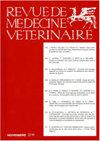丹诺沙星在肉鸡血浆和可食用组织中的处置
Q2 Veterinary
引用次数: 0
摘要
本研究旨在研究达诺沙星在肉鸡体内的配置,建立其在血浆和组织中的药动学参数,并估计停药期。将42只成年鸡分为14组,每组3只,分别在给药前12 h和给药后3 h禁食,单次口服达诺沙星5 mg/kg。每个批次在预先设定的时间内牺牲,并在应用后长达120小时的时间内获得血液,肌肉和肝脏样本。该方法采用液-液萃取法对分析物进行分离和定量。使用PK Solution软件分析血浆和组织浓度的时间平均值。采用WT 1.4程序,以鸡肌肉和肝脏的最大残留限量(MRL)分别为200和400 μg/kg计算停药期。丹诺沙星吸收迅速,Cmax为1.1 μg/ml, Tmax为1 h;T½β (h)为7.64;血浆、肝脏和肌肉分别为6.16和12.77;Vd为5.51 L/kg;肌肉和肝脏的组织/血浆比率分别为0.48和6.61,且浓度可达72小时。根据残留浓度分析,肌肉和肝脏的停药期分别为1.4和3.34 d。本文章由计算机程序翻译,如有差异,请以英文原文为准。
Disposición de danofloxacina en plasma y en tejidos comestibles de pollos parrilleros
This paper aimed to study the disposition of danofloxacin in broiler chickens in order to establish pharmacokinetic parameters in plasma and tissues and to estimate a withdrawal period. 42 adult chickens were divided into 14 groups of 3 individuals each, who received a single oral dose of 5 mg/kg of danofloxacin after a fasting period of 12 h before and 3 h post-administration. Each batch was sacrificed at pre-established times, and blood, muscle, and liver samples were obtained over a period of up to 120 h post-application. The assay consisted of the liquid-liquid extraction of analyte and its separation and quantification by high-performance liquid chromatography (HPLC). Time averages for plasma and tissue concentration were analyzed using the PK Solution software. Withdrawal period was calculated using the WT 1.4 program, based on maximum residue limits (MRL) of 200 and 400 μg/kg, established for chicken muscle and liver, respectively. Danofloxacin exhibits a rapid absorption, resulting in a Cmax of 1.1 μg/ml with a Tmax of 1 h; t½β (h) was 7.64; 6.16 and 12.77 in plasma, liver, and muscle, respectively; a Vd of 5.51 L/kg; tissue/plasma ratios of 0.48 and 6.61 in muscle and liver, respectively, and levels up to 72 h. Based on residual concentration analysis, a withdrawal period of 1.4 and 3.34 d was estimated for muscle and liver, respectively.
求助全文
通过发布文献求助,成功后即可免费获取论文全文。
去求助
来源期刊

Revue De Medecine Veterinaire
农林科学-兽医学
CiteScore
1.30
自引率
0.00%
发文量
0
审稿时长
18-36 weeks
期刊介绍:
The Revue de Médecine Vétérinaire publishes four kinds of text:
1) Scientific reviews on subjects related to veterinary and comparative medicine. Suggested length: 10 to 30 typed pages.
2) Original reports on fundamental or applied research. Suggested length: 10 to 15 typed pages.
3) Continuous education articles, that should be easily understandable by non-specialists. Suggested length: 10 to 15 typed pages.
4) Clinical reports. Suggested length: 5 to 15 typed pages.
The publication can be done in French language or English language.
For an article written in English by not english native speakers authors, the manuscript must be subjected by attesting that it was read again by an anglophone scientist or a scientific translator.
The authors must certify that the manuscript was not published or subjected for publication to another review.
The manuscript must be accompanied by a sheet signed by all the joint authors indicating their agreement for the tender of the manuscript.
The publication is free but a financial participation could be required for the photographs color. An estimate will be sent to collect the agreement of the authors.
 求助内容:
求助内容: 应助结果提醒方式:
应助结果提醒方式:


